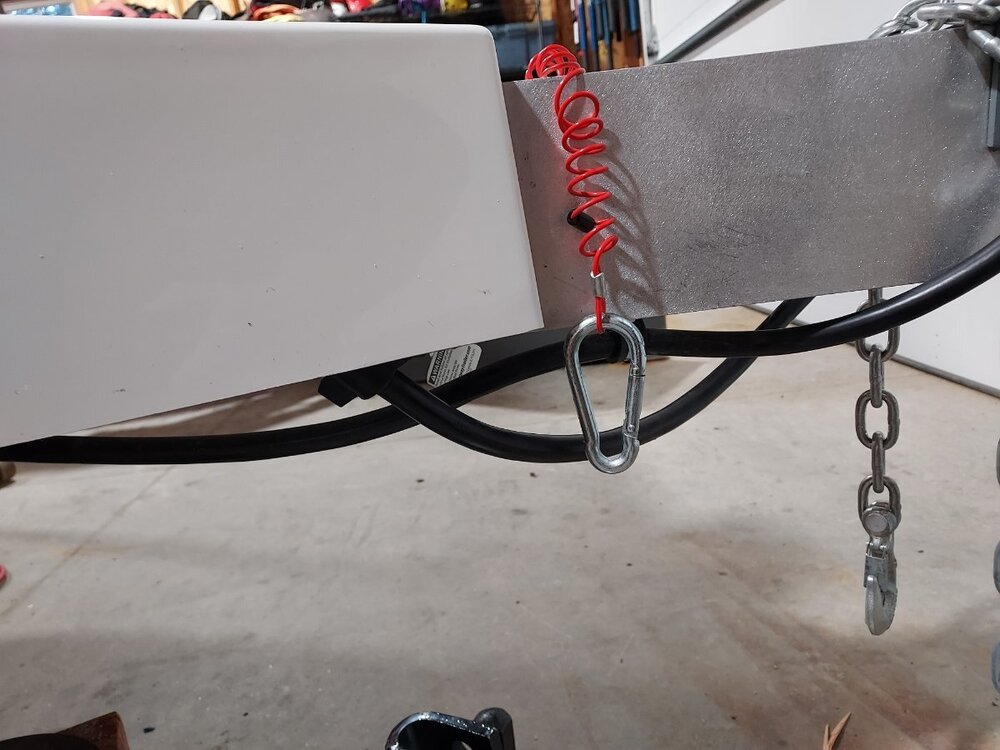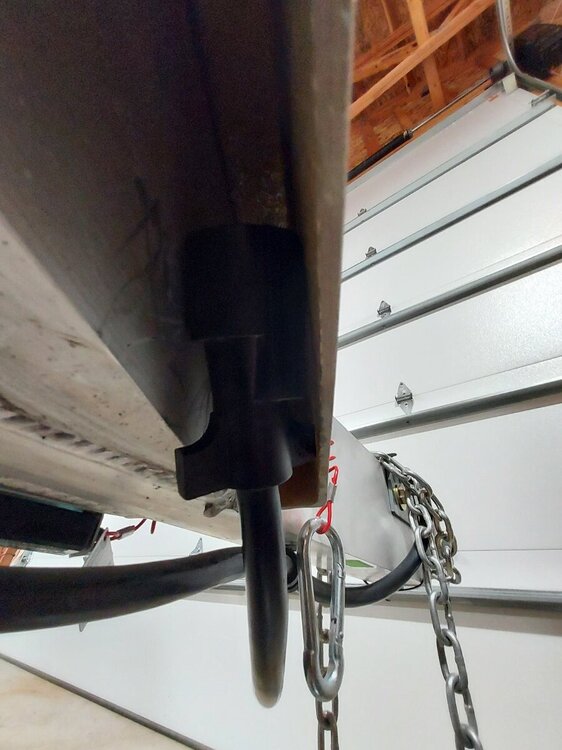-
Posts
945 -
Joined
-
Last visited
-
Days Won
18
Everything posted by Rivernerd
-
Just think how pleasant it would be to hang out inside the black Oliver on a 100+ degree day, particularly with a Demonic air conditioner. We like our Oliver white, and we love our Truma AC.
-
We have camped in ambient temps as low as 9 degrees F with the furnace running on propane (nearly full time to keep up). We pulled the outside shower head inside the hull by twisting it off, then putting it back on inside. Our remote thermometers in the belly of Hull #1291 reported temps down to 33 degrees F, but not below. No freeze damage. Whew! That said, I do not recommend camping in an Elite II in temps below 15 degrees F, to be safe. With lows in the 20s F, you should be o.k. with the furnace running. Towing an Elite II in sub-freezing temps is a different issue, as it is potentially dangerous to run the furnace on propane while on the road. And, your water heater is at risk unless you have a Truma with the antifreeze adapter. On the trip mentioned above, we did our travel mid-day, when temps were above 32 F, because we choose not to run the propane furnace unless we are parked.
-
You are very kind. As a retired attorney whose litigation practice included defense of auto claims involving life-altering catastrophic injuries, I am not so generous. Cutting corners with a critical safety system, like legally-mandated trailer brakes, is not "genius;" it is remarkably stupid and grossly negligent. Given this discovery of such sloppy work, Oliver would be well advised to verify the efficacy of trailer brakes on each Elite II before they allow it to leave the factory.
-
How did you resolve the issue? Was it just a failed connector which was replaced, or should the two blue and one red wires be separated? If so, what should they be connected to? Where, exactly, under the bed on the driver's side in a 2022 Elite II should I look? Had you been involved in a catastrophic accident where functioning trailer brakes would have made a difference, the photo of the shrink-wrap solder connector you attached should have made Oliver a defendant in the case, and ultimately liable for a large percentage of any awarded damages. Such revelations demonstrating Oliver's obvious lack of production quality control, even in 2022, are disturbing to me. Whoever was responsible to verify the integrity of electrical connections was obviously asleep on the job. We have Hull #1291, one of the last built in the 2022 model year. Your post makes me glad I verified, and adjusted, trailer brake function on the road leading away from the Oliver Service Department facility right after we accepted delivery of the trailer. I recommend that anyone taking delivery of a new Oliver do the same. Particularly if their tow vehicle is not a 1-ton like yours!
-
As the issue seems to be 12V, what kind of batteries do you have? How old are they? Have you tested battery voltage with a multimeter?
-
Hydraulic spring compressors are easy to operate, and are pretty safe. See link below for $129, with free shipping: https://www.vevor.com/strut-spring-compressor-c_10324/vevor-strut-spring-compressor-4-5-ton-9920-lbs-hydraulic-jack-capacity-1-ton-rated-compression-force-auto-strut-coil-spring-compressor-tool-hydraulic-spring-compressor-for-strut-spring-removing-p_010965229806?adp=gmc&srsltid=AfmBOopoeYWWikeQmCcGKl47slQH4-rLCtrA7WJZn_-l09Cs4PORifLmAoo That is what I would do in your shoes.
-

Broke a Leaf Spring in Maine
Rivernerd replied to Galway Girl's topic in Mechanical & Technical Tips
I bought them so I could replace them myself when time allowed. Other commitments have, so far, been higher on the priority list, This is largely because Hull #1291 has spent much less time on the road than we hoped when we bought it, so miles are still low. I don't know what the weight rating is, but I believe it far exceeds that of the 4-leaf factory springs. I don't plan to replace the shocks yet. -

Broke a Leaf Spring in Maine
Rivernerd replied to Galway Girl's topic in Mechanical & Technical Tips
Thanks for posting. All Oliver owners need to know that the factory 4-leaf springs have a limited life, and that springs often fail far from home, because that is when they are asked to flex the most. That is why I now have a set of four Alcan 5-leaf springs for my Elite II. -
Another option that is also protected from rain: stuff the 7-pin up between the fiberglass housing and the aluminum a-frame. See photos below.
-

Fridge Problems only on Propane
Rivernerd replied to carnivore's topic in Mechanical & Technical Tips
Have you opened a ticket with Oliver Service? They may know. -
Me too. When inflated to about 20 PSI, it helps eliminate "jounce" when going over bumps.
-
The sensor inaccuracy is not limited to "older hulls." The fresh tank sensor on our 2022 Elite II reads 68 percent when full, with water draining out of the overflow. When the tank gets low, we have to guess how much water is left...
-
Maybe under the galley sink, and then the bathroom? I would check for leaks under the galley sink first, as water there can cause major issues. If the connections under that sink looks good, I would carefully examine the bath faucet and toilet supply line connections. Good luck! And, please report your results.
-
Happy Campers RV Holding Tank additive eliminated gray tank odors for us.
-
Yes, I have. My 2008 Tundra 5.7L with tow package has a factory transmission cooler, and I was unhappy when I learned that my 2019 5.7L with tow package did not. After following a thread on this forum addressing the topic, I bought a Veepeak OBD II scanner that reports via Bluetooth to my Android phone. Towing our Hull #1291 up a long hill on a 100-degree day in August 2023 our transmission pan temp got up to 263 F. Although Toyota claims that up to 300 F is "o.k." with proprietary Toyota transmission fluid, a (2020, I think) Tundra owner who posted on this forum repeatedly overheated, and then blew his transmission, towing an Elite II across the USA in summer temps. I then considered replacing the Tundra with a 3/4 ton GMC. But last winter, I ultimately chose to buy and install an aftermarket transmission cooler in the Tundra, as I still love Toyota reliability. In July 2024 towing our Oliver up that same hill on a 98-degree day, the transmission pan temp maxed out at 232 degrees F. We are keeping the modified 2019 Tundra for now.
-

Beech lane levelers for for Legacy Elite II
Rivernerd replied to a topic in Mechanical & Technical Tips
For what it's worth, the Rophor levelers are ribbed (not smooth like the Andersens), and come with the rubber mats for placement underneath the levelers on hard surfaces. We have used them for almost two years now with no slippage or other issues. -
I know the Tundra is classified by the automotive industry as a "1/2 ton", but my 2019 SR5 double cab standard bed Tundra with tow package has 13.9" and 13.6" disc brakes, a 5.7L V8 engine, and almost 3/4 ton (1480 lbs.) of payload capacity. With the Anderson WD hitch, that's close enough to "3/4 ton" for my purposes.
-
Replacing some of the extra chain links required to connect the Anderson weight distribution hitch to an Oliver Elite II with turnbuckles is another method that eases whale tail installation. I carry Robogrips in my Tundra to enable easy turning of the turnbuckles. The turnbuckles allow me to adjust chain tension without getting on the ground under the trailer. l generally favor Steve Morris' "move the tow vehicle" approach detailed in his post above, but there have been occasions when I was glad I had installed the turnbuckles. See the posts starting with one by John Davies dated November 26, 2022 from the below thread:
-
Yes, I am satisfied with the 390 Ah of Lithionics LiFePO4 batteries in our 2022 Elite II. I got educated about batteries and solar panels more than 20 years ago when I needed to power a CPAP machine on wilderness river trips. At that time, the best batteries commercially available were AGMs, which are sealed but are lead/acid based. I replaced them every 3 years to avoid failure on a long remote river trip. I studied lithiums for years, and finally "bit the bullet" and bought some to power my CPAP when prices came down about 5 years ago. So, when ordering our Oliver, I was persuaded that the significant upcharge for the lithium package, given our plans to boondock, made sense for us. Your recent posts on this thread suggest you have resolved your current issue by cleaning the terminals on your 6V AGMs. But, depending on how "fresh" your AGMs were when installed in your 2021 Elite II, you likely have between a few months and 4 years of remaining life, as lead/acid chemistry only lasts between 3 and 7 years from date of manufacture. And, deep discharge (like you have just experienced) shortens the life of any AGM battery. In your shoes, I would carefully study the recent posts by helpful Oliver owners on this forum who have installed Epoch LiFePO4 batteries, including those in the thread listed above by jd1923, and make an informed decision about whether the lithium upgrade makes sense for you. Every time we boondock, we are grateful we "bit the bullet" for the Lithium Pro package on our Elite II.
-

Beech lane levelers for for Legacy Elite II
Rivernerd replied to a topic in Mechanical & Technical Tips
I concur with Ronbrink's advice. We use the Rophor system, which has worked well for us for the past two years, and is less expensive than some competitive products: https://www.amazon.com/Rophor-Leveler-Version-Leveling-Non-Slip/dp/B09NJSXRRB/ref=asc_df_B09NJSXRRB/?tag=hyprod-20&linkCode=df0&hvadid=693330410595&hvpos=&hvnetw=g&hvrand=15739391212809512128&hvpone=&hvptwo=&hvqmt=&hvdev=c&hvdvcmdl=&hvlocint=&hvlocphy=9029558&hvtargid=pla-1637492471943&psc=1&mcid=8b6eff5b433a3cedbac02e4e81b209a9 -
Yep. How old are your AGM batteries? The symptoms you describe are consistent with dead batteries. Have you verified voltage directly on the battery terminals with a multimeter? If not, this is a good time to buy a decent quality multimeter and learn how to use it to check DC voltage. I have had good luck with Kleins: https://www.amazon.com/Klein-Tools-MM325-Multimeter-Manual-Ranging/dp/B0B57L9FNL/ref=sr_1_3?dib=eyJ2IjoiMSJ9.61XKRl89-3qY_jOJ1tlRT6tFtXNi8iiTpXqgzJqMZsrq7RzLpFwfoWRgEHYrZp8penyQEogP6kuBaZthL2fdJqqzGaPZUGzR4Ve04WpsxcPqWYRXosVndFIsRAyHUEfeWwL2wFYskycszgVtiIZzkz10nH_v2yqeby4RP-ofXUq1_amtpf375sJDuy6KSDEZA3IShhRIX0z0PPh9ONsoOL32aw9119j9kyiVMmCjXJksbjlqQs6LxNXerLk8LHfRdd_4gJTGyRX2_9tTVMGDmBpCQP2MtLlTKd0NF4x6DpU.At0pL72QN-091RMJyRyQ4TbKFEcmWWFbNvncC9xG1qA&dib_tag=se&hvadid=580671312857&hvdev=c&hvlocphy=9029558&hvnetw=g&hvqmt=e&hvrand=7645837832001151333&hvtargid=kwd-29526678819&hydadcr=8432_13498106&keywords=klein%2Bmultimeter&qid=1726585739&sr=8-3&th=1 "Healthy" 12 volt AGMs should read at least 13V after charging. Any reading after recharge below 13V indicates a dead, or dying, AGM battery. If your AGMs are dead, I recommend you invest the time now to get educated about the pros and cons, including cost, of switching to Lithium Iron Phosphate (LiFePO4) going forward vs. buying a new set of AGMs. Since you boondock (like we do), if you plan to keep your Oliver for at least another 5 years, I believe the upgrade to LiFePO4 would pay off long term. The initial investment in Lithium batteries (and other components of a retrofit) is much higher, but they last at least twice as long and provide more usable 12V power per amp hour than AGMs. This long string may provide a helpful starting point: Good luck!
-
Looks like 5 to me...
-

Newbies Looking for an Oliver and Camping Mentor
Rivernerd replied to Mike Spies's topic in General Discussion
You are now connected with a large group of willing mentors who, collectively, have nearly encyclopedic knowledge of camping with Oliver trailers. This forum is one of the best resources on those topics available anywhere. IMHO, the forum is better than any one mentor. Ask away! -

SeeLevel 2 only Reads 19 & 38 on Fresh Tank
Rivernerd replied to I M in KS's topic in Mechanical & Technical Tips
Bad sensors. Like those who posted above, we have learned that our fresh, gray and black tank sensors are terribly inaccurate. Our fresh tank sensor, for example, reads 68% when the tank is overflowing (and therefore clearly full) with the trailer level.







